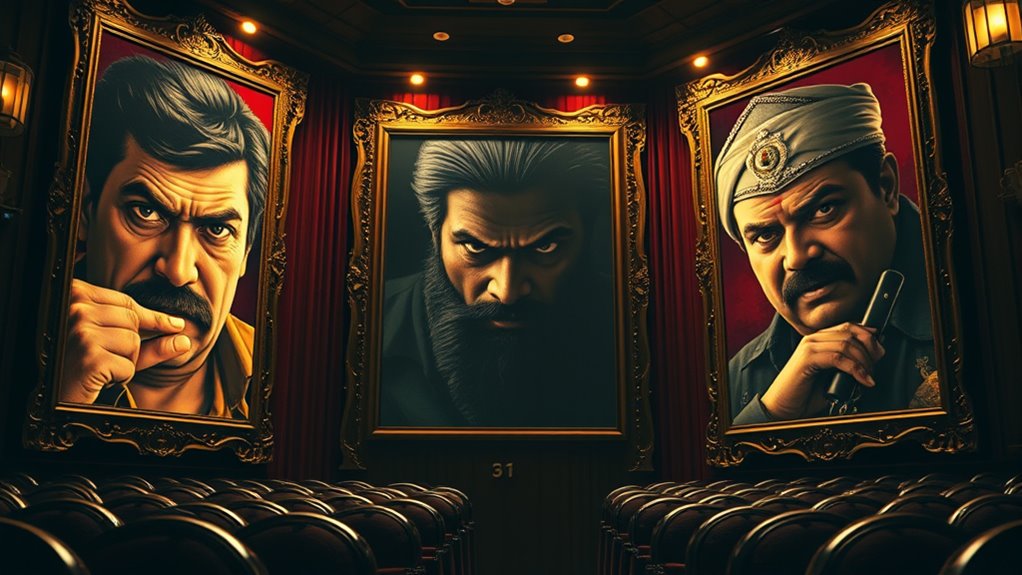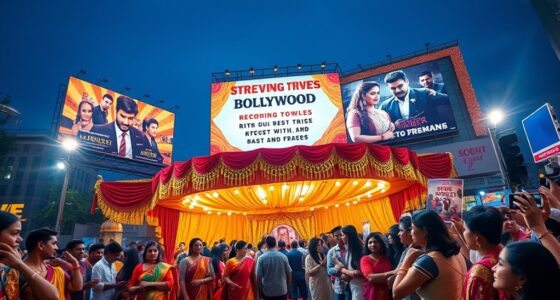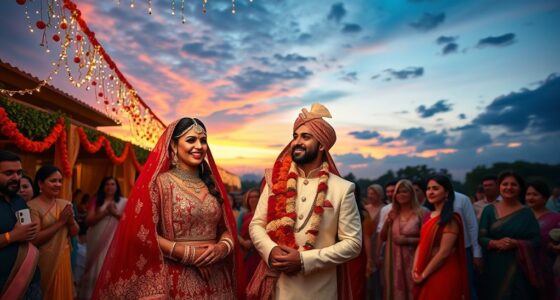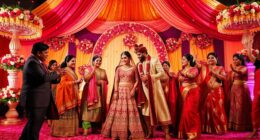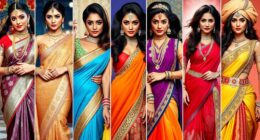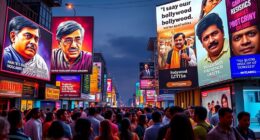Iconic Bollywood villains like Gabbar Singh and Mogambo have profoundly shaped cinema, blending menace, charisma, and cultural impact. Their powerful screen presence set standards for villain archetypes, influencing storytelling, character development, and popular culture for generations. Many of their lines and traits remain etched in public memory, inspiring parodies and references today. To understand how these villains continue to define Indian cinema and society, there’s more to explore beyond the surface.
Key Takeaways
- Classic villains like Gabbar Singh and Mogambo set the standard for charisma, menace, and cultural impact in Bollywood cinema.
- Their memorable dialogues, mannerisms, and larger-than-life personas have become ingrained in popular culture and parodied widely.
- The evolution from stereotypical antagonists to multi-dimensional characters has enriched storytelling and influenced modern villain portrayals.
- Iconic villains continue to inspire actors, filmmakers, and character archetypes, ensuring their legacies endure across generations.
- Their role as societal symbols and reflections of cultural fears enhances the depth and social relevance of Bollywood films.
The Rise of the Classic Villains in Bollywood
The rise of the classic villains in Bollywood can be traced back to the 1970s when filmmakers began crafting memorable antagonists who left a lasting impact on audiences. Gabbar Singh from *Sholay* (1975) became the epitome of menace, with unforgettable dialogues and mannerisms that still resonate today. Following that, larger-than-life characters like Mogambo from *Mr. India* (1987) and Shaakal from *Shaan* (1980) introduced eccentricity and style to villainy. These characters weren’t just evil; they became cultural icons, with catchphrases entering everyday language. Their powerful screen presence often drove box office success, and their influence shaped future films. These villains set the standard for memorable antagonists, blending menace, charisma, and style, ensuring their place in Bollywood history. The depiction of extreme violence and brutality in classic films contributed to their reputation as formidable foes. Additionally, their iconic dialogues often became part of popular culture, further cementing their legacy.
Traits and Characteristics of Memorable Antagonists

Memorable antagonists stand out because of their traits that command attention and evoke strong reactions. They have a commanding presence that makes them impossible to ignore, like Amrish Puri’s Mogambo. Leaders like Gabbar Singh maintain control through fear and strategic manipulation. Many combine sophistication with ruthlessness, making them both charismatic and formidable. Their complex motivations, such as those portrayed by Danny Denzongpa, add depth and intrigue. Psychological traits also play a role; characters like Ashutosh Rana’s psychopathic killer show unpredictability and chilling realism. These villains often possess emotional depth, making them more relatable and engaging. Their traits serve to contrast heroes, drive the plot, and highlight themes like power or corruption, leaving a lasting mark on audiences and cinema alike. Villains’ psychological complexity significantly contributes to their memorable status and enduring impact. Understanding the psychological traits of these antagonists helps explain their lasting appeal and influence in cinema history. Additionally, their ability to evoke strong emotional responses is often rooted in their psychological depth, which enhances their realism and memorability. Recognizing the importance of character development in crafting compelling villains emphasizes how layered personalities contribute to their impact. Moreover, the diverse range of cultural influences provides these characters with unique backgrounds that deepen their complexity and appeal. These elements combined make them iconic figures in cinematic history, ensuring their relevance for generations.
Cultural Influence and Parodies of Iconic Villains
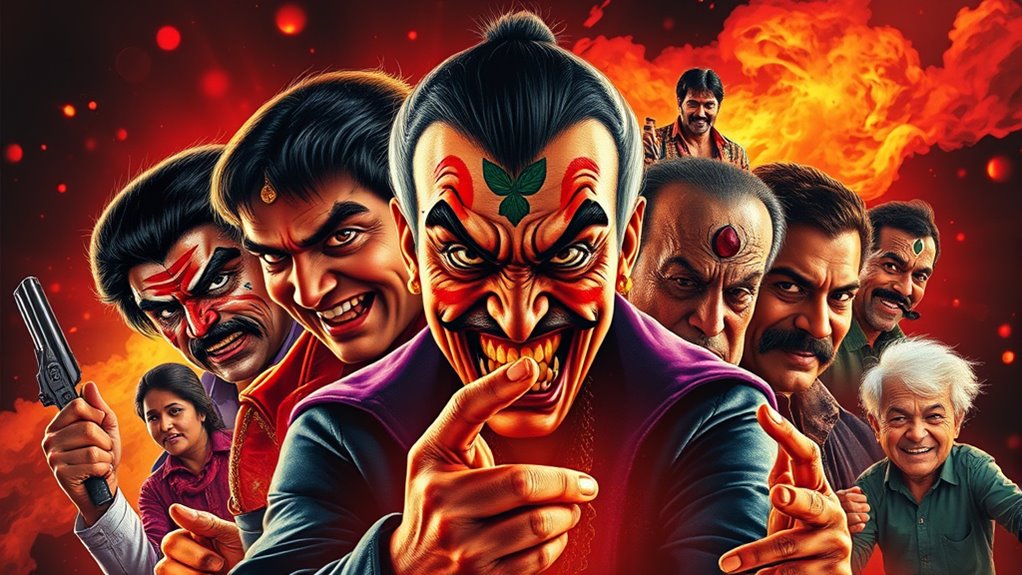
Iconic Bollywood villains resonate deeply within popular culture, often transcending their original film roles to become symbols of societal fears and issues. You’ve likely heard lines like Gabbar Singh’s “Kitne aadmi the” or Mogambo’s “Mogambo khush hua,” which have become part of everyday conversations. Their characters often symbolize societal struggles, reflecting injustices faced by many. These villains’ distinctive dialogues and mannerisms have been widely parodied, creating a cultural imprint that endures over decades. Parodies and homages keep their legacy alive, appearing in films, TV shows, music, and theater, often humorously referencing their traits. These portrayals influence international cinema and are frequently featured in memes and jokes, highlighting their lasting impact. Their presence in pop culture not only entertains but also offers social commentary, shaping perceptions and reinforcing cultural identities rooted in the stories these villains tell. These characters have become archetypes that define villainy in Indian cinema and continue to inspire new generations of filmmakers and audiences alike. Additionally, their cultural influence extends beyond film, inspiring fashion, dialogue, and even political discourse, which underscores their enduring significance in society. Moreover, their iconic status often prompts discussions about morality, justice, and societal values, making them more than just fictional antagonists. The evolution of their portrayals over time reflects changing societal norms and cinematic trends, ensuring their relevance persists. Their pervasive presence in media ensures that their influence remains relevant across different generations and cultural shifts.
Evolution of Villainy in Indian Cinema
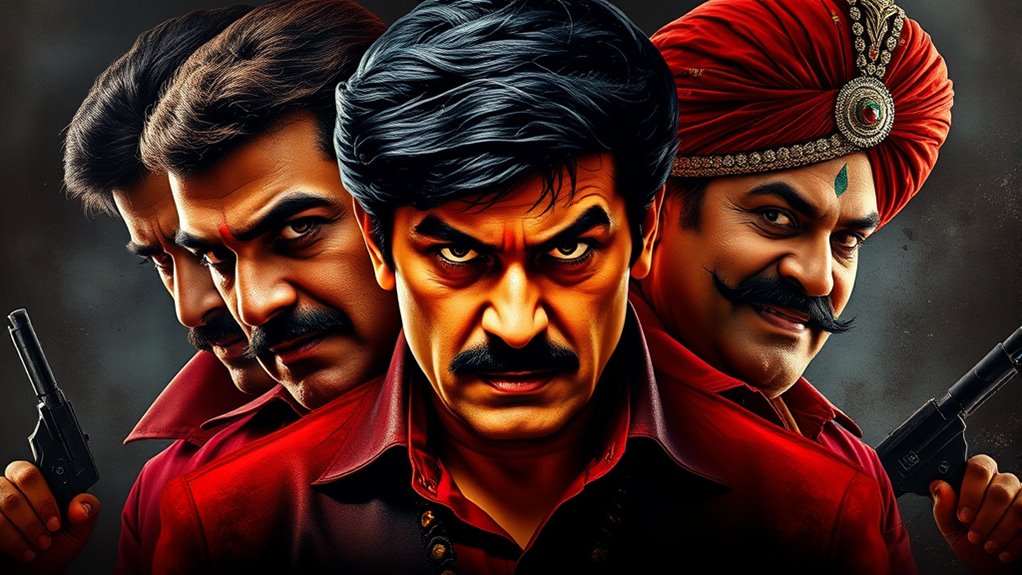
As Indian cinema has evolved, so too has the portrayal of villains, shifting from simple embodiments of evil to complex, multi-dimensional characters. You now see villains with layered motivations, reflecting societal changes and psychological depth. This evolution includes:
- Moving from stereotypes like feudal zamindars to modern figures representing industrial or corporate power.
- Drawing inspiration from global cinema to craft more nuanced, relatable antagonists.
- Developing anti-heroes that blur hero-villain boundaries, adding complexity.
- Humanizing villains with backstories that evoke empathy, making their actions more believable.
- The shift towards multi-dimensional characters has allowed filmmakers to explore deeper themes and foster greater audience engagement. Additionally, incorporating interior design elements, such as antique accents, can create visual storytelling that complements character development and enhances the cinematic atmosphere. This trend toward character complexity has also encouraged directors to explore darker, more mature themes, broadening the scope of Indian storytelling. These shifts have transformed villains from mere obstacles into essential elements that drive storytelling, reflect societal issues, and deepen character development. The evolution enhances cinematic richness and keeps audiences engaged with more sophisticated narratives.
The Legacy of Golden Era Villains
The legacy of golden era villains in Bollywood continues to shape Indian cinema, leaving an indelible mark on storytelling and character development. These villains set a standard with their distinct acting styles, memorable dialogues, and visual presence. Actors like Pran, K. N. Singh, Jeevan, Madan Puri, and Jayant defined the era, inspiring future generations. Their roles drove plots, added depth, and reflected societal issues of their time. Today, modern villains draw inspiration from these icons, maintaining their relevance and cultural impact. Their performances, characterized by emotional complexity and unique costumes, created a lasting impression. This influence extends beyond films into popular culture, ensuring their legacy endures. The character archetypes they portrayed continue to influence how villains are depicted in contemporary cinema.
Frequently Asked Questions
How Have Modern Bollywood Villains Differed From Classic Ones?
You notice modern Bollywood villains are more nuanced and realistic compared to the classic ones. Instead of over-the-top caricatures, they show psychological depth and reflect societal issues like greed and corruption. Their performances blend intelligence with malevolence, making them more relatable and engaging. Audience expectations drive this change, leading to complex storylines and characters that mirror real-world complexities, ultimately elevating the film’s storytelling and cultural relevance.
What Psychological Traits Make Villains Memorable Beyond Their Dialogues?
You notice that villains become memorable through their psychological traits, not just their dialogues. Their cognitive-emotional imbalance, like being calculating yet detached or chaotic yet intense, makes them unsettling. Uncanny traits and idiosyncrasies add to their memorability, while their psychological manipulation deepens your sense of dread. When villains mirror or threaten your self-image, you feel a subconscious discomfort that lingers, making them psychologically impactful and unforgettable beyond their spoken lines.
How Do Bollywood Villains Influence International Cinema?
You can see how Bollywood villains influence international cinema through their complex character development and narrative roles. They inspire nuanced, multi-dimensional antagonists, shaping storytelling techniques worldwide. Their dramatic dialogues and distinctive personalities add depth to plots, while Bollywood’s blend of music and drama influences global productions. As Bollywood continues evolving, its villains’ cultural impact grows, pushing international filmmakers to adopt richer, more engaging villain portrayals that resonate across diverse audiences.
Which Actors Are Considered the Most Iconic Villains Today?
You see actors like Arjun Kapoor, R. Madhavan, and Kamal Haasan commanding the screen as today’s iconic villains, embodying cunning, brutality, and complexity. They challenge heroes, evoke fear, and leave lasting impressions, much like their legendary predecessors. These actors bring psychological depth, versatility, and cultural significance to their roles, making villains memorable and shaping modern cinema’s landscape. Their performances continue to inspire and captivate audiences worldwide.
What Role Do Villains Play in Shaping Indian Societal Narratives?
Villains in Indian cinema shape societal narratives by reflecting and challenging social issues. You see, they act as mirrors to corruption, injustice, and evolving cultural norms, influencing public perceptions. Their stories often spark conversations about morality and social change, making audiences question the status quo. Through these characters, you’re engaged in a broader dialogue about societal values, making villains essential to understanding India’s complex social fabric.
Conclusion
So, next time you see Bollywood villains on screen, remember they’re not just bad guys—they’re the stars of a thousand memes and parodies. Their larger-than-life antics turn serious crime into slapstick comedy, making you wonder if they’re villains or just misunderstood actors auditioning for a comedy show. In the end, these iconic villains leave a lasting mark, proving that even in darkness, Bollywood knows how to make you laugh, cry, and cheer—sometimes all at once.
